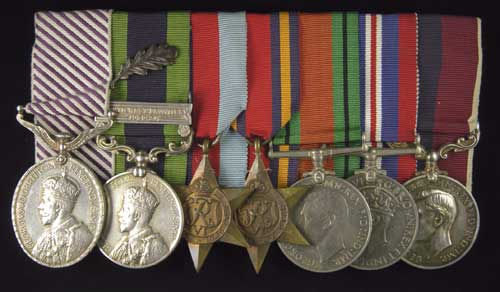
Auction: 7012 - Orders, Decorations, Medals & Militaria
Lot: 603
The Extremely Rare ´Crowned Head´ North West Frontier Chitral Reliefs 1932 D.F.M. Group of Seven to Wireless Operator/Air Gunner, Later Flight Lieutenant L.J. Strevens, Royal Air Force a) Distinguished Flying Medal, G.V.R., 2nd ´Crowned Head´ type (370030. Cpl. L.J. Strevens. R.A.F.) b) India General Service 1908-35, G.V.R., one clasp, North West Frontier 1930-31, M.I.D. Oakleaf (370030. L.A.C. L.J. Strevens. R.A.F.) c) 1939-1945 Star d) Burma Star e) Defence and War Medals f) Royal Air Force Long Service & G.C., G.VI.R., 1st ´Ind: Imp:´ type (Flt. Lt. L.J. Strevens. R.A.F.), generally good very fine or better, mounted court style for wear, with two Flying Log Books (25.3.1929-28.6.1934 and 5.7.1934-1.7.1938), bound together (7) Estimate £ 6,000-6,500 D.F.M. London Gazette 8.9.1933 370030 Corporal Lloyd Jesse Strevens R.A.F. ´In recognition of gallant and distinguished services rendered during the operations in connection with the Chitral Reliefs, September to October, 1932.´ M.I.D. London Gazette 26.6.1931 Strevens, No. 370030 Leading Aircraftman L.J. R.A.F. ´For distinguished services rendered during Operations on the North West Frontier of India during the period, 23rd April to 12th September, 1930.´ Strevens was initially recommended for a D.F.M., the Recommendation, dated 27.10.1930, states: ´Between the 7th May and 2nd September, 1930, from Risalpur N.W.F.P., this airman has taken part in some 62 reconnaissances and bomb raids over hostile tribal territory. His work as an Air Gunner and as a Wireless Operator has been of a very high standard throughout the operations.´ Flight Lieutenant Lloyd Jesse Strevens, D.F.M., posted Wireless Operator/Air Gunner 11 (B) Squadron, Miranshah (Wapiti´s), 25.3.1929; took part in several V.I.P. flights in April 1930, including the Viceroy; flew in nearly 80 operational sorties with the squadron, primarily bombing raids and reconnaissance ops over Mohmand Territory and the Chitral Relief, May-September 1930. Every two years the garrison at Chitral (North West Frontier) underwent a changeover. This was quite a sizeable undertaking, given that the new incumbents of around 1500 in number had to march for 36 days through frequently hostile territory (Dargai to Chitral) to reach the fort. Quite a logistical feat given that the garrison changeover also involved an escort and a larger support force. September 1930 heralded the Royal Air Force´s first involvement in the process, with Streven´s 11 (B) Squadron and 39 Squadron assisting the army. Flying from Risalpur the two squadrons supplied the column of troops and 850 animals with supplies for two days. Three tons of rations and forage were dropped in specially made 56lb containers carried on the bomb racks of the Wapiti. Each aircraft averaged four sorties a day, dropping the supplies at pre-arranged night halting points, ´Parachute supply dropping for Chitral Column´, 3.9.1930 (Log Book refers). The tribal situation was unusually placid in 1930 and as such the Nawab of Dir was able to guarantee safe passage for the changeover and the troops reached the fort without major incident. During 1931 Strevens took part in 15 operational sorties, mainly over Mohmand and Afridi territories. In the first four months of 1932 the frequency of sorties drastically increased with Strevens flying in 58 reconnaissance, bombing and ´Red Shirt´ patrols. In August the squadron converted to Hawker Hart aircraft, just in time to be acclimatised to the new planes in preparation for the Chitral garrison relief. In September 1932 Strevens took part in his second biennial relief of the Chitral garrison. Unlike the previous relief in 1930, a number of anti-British dissidents succeeded in making the passage of the column as uncomfortable as possible. A number of lashkars of hostile tribesmen engaged the Narwab´s forces at every opportunity, resulting in him being unable to guarantee safe passage for the relief column. In light of this five squadrons (No´s 11, 20,27,39 and 60) were placed under the control of the Commander of Peshawar District, to deal with all hostile action taken against the column. Notice was given to the local people that bombing would be used in retaliation to all acts of aggression against the column. The aircraft, however, were regularly met with heavy rifle fire and as a result of this selected targets were bombed between the 17th and 23rd September. Strevens flew in 36 bombing raids between September and October, often with his commanding officer Squadron Leader Houghton as his pilot, leading the bombing formation (see D.F.M.). Once the changeover was completed the R.A.F. focus was shifted to securing the submission of the Shamozair territory. The five squadrons involved, including Strevens´, continued a reduced bombardment on the area until 16th October, when the tribal representatives met with the Political Agent and agreed a cease in hostilities. Strevens postings after 1932 included to: 23 (Fighter) Squadron, Northolt (Hawker Demons), 26.5.1933 and he took part in the Royal Review Fly Past with the latter, 6.7.1935 (Log Book refers); posted 74 Squadron, Demon Flight, R.A.F. Hal Far, Malta, 23.9.1935; posted 103 (B) Squadron, Andover (Hinds), 23.10.1936 and the squadrons subsequent move to Usworth, 4.3.1937; posted 101 (B) Squadron, Bicester, 3.7.1937; and 82 (B) Squadron, October 1937. Only 3 D.F.M.s were awarded for these operations, from a total of only 22 ´crowned head´ D.F.M.s issued between 1931 and 1937.
Sold for
£7,000




